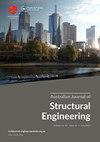点蚀参数对钢索残余疲劳寿命的影响
IF 1.3
Q4 ENGINEERING, CIVIL
Australian Journal of Structural Engineering
Pub Date : 2023-03-27
DOI:10.1080/13287982.2023.2190648
引用次数: 0
摘要
腐蚀损耗是导致电缆钢丝(CSW)结构承载能力下降的一个重要因素。本文旨在研究点蚀参数对钢丝绳残余疲劳寿命的影响,以便拟合一系列公式,直接快速地预测钢丝绳的残余疲劳寿命。首先,对单点蚀和双点蚀的csw进行有限元模拟。其次,计算了腐蚀后csw的应力集中系数和残余疲劳寿命;最后,拟合了不同坑深和坑宽条件下csw的SCFs和RFLs的计算公式。结果表明:随着坑深的增加,SCF增大,随着坑宽的增加,SCF减小;RFL随坑深的增加而减小,随坑宽的增加而增大。SCF和RFL与腐蚀坑的数量无关,只受最深坑的深度影响。本文章由计算机程序翻译,如有差异,请以英文原文为准。
Influence of pitting corrosion parameters on the residual fatigue life of a steel cable
ABSTRACT Corrosion wastage is a significant factor that leads to load bearing capacity degradation of cable steel wire (CSW) structures. This paper aims to study the influence of pitting corrosion parameters on residual fatigue life (RFL) of a steel cable, so as to fit a series of formulas to predict the RFL of steel cables directly and quickly. Firstly, single and double pitting corroded CSWs are modelled by FEM. Secondly, stress concentration factors (SCFs) and residual fatigue lives (RFLs) of the corroded CSWs are calculated. Finally, calculation formulas of SCFs and RFLs of the CSWs with various pit depths and widths are fitted. The results show that SCF increases with the increase of pit depth and decreases with the increase of pit width. RFL decreases with the increase of pit depth and increases with the increase of pit width. SCF and RFL have nothing to do with the amount of corrosion pits, but only affected by the depth of the deepest pit.
求助全文
通过发布文献求助,成功后即可免费获取论文全文。
去求助
来源期刊

Australian Journal of Structural Engineering
ENGINEERING, CIVIL-
CiteScore
2.50
自引率
0.00%
发文量
31
期刊介绍:
The Australian Journal of Structural Engineering (AJSE) is published under the auspices of the Structural College Board of Engineers Australia. It fulfils part of the Board''s mission for Continuing Professional Development. The journal also offers a means for exchange and interaction of scientific and professional issues and technical developments. The journal is open to members and non-members of Engineers Australia. Original papers on research and development (Technical Papers) and professional matters and achievements (Professional Papers) in all areas relevant to the science, art and practice of structural engineering are considered for possible publication. All papers and technical notes are peer-reviewed. The fundamental criterion for acceptance for publication is the intellectual and professional value of the contribution. Occasionally, papers previously published in essentially the same form elsewhere may be considered for publication. In this case acknowledgement to prior publication must be included in a footnote on page one of the manuscript. These papers are peer-reviewed as new submissions. The length of acceptable contributions typically should not exceed 4,000 to 5,000 word equivalents. Longer manuscripts may be considered at the discretion of the Editor. Technical Notes typically should not exceed about 1,000 word equivalents. Discussions on a Paper or Note published in the AJSE are welcomed. Discussions must address significant matters related to the content of a Paper or Technical Note and may include supplementary and critical comments and questions regarding content.
 求助内容:
求助内容: 应助结果提醒方式:
应助结果提醒方式:


